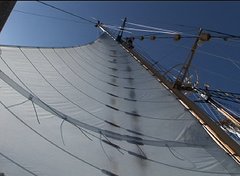My responsibility toward the end of our six-hour watch was to stand at the bow and look out over the air and water ahead of the ship. By then, the eastern sky was excitedly anticipating dawn. I waited for the sunrise by doing box step-ups and calf raises – great on-ship exercises. As I finished, the cumulus clouds ahead of the bow blushed pink, and the cirrus behind us caught fire. The sails, shrouds, and lines of the Seamans were black silhouettes, an angular negative space in the dawn’s watercolor wash. Kiara came out from below deck, and we watched, quiet. The start of our third day of Stanford at Sea, though days themselves now feel irrelevant given our watch schedule of six hours on watch, twelve hours off.
After my watch passed instructions to the next and Jordan relieved me at the bow, we consummated the transfer of authority with a hearty cry of “chief mate has the con!” and cheered our success. Inexplicably invigorated – or perhaps just more delirious after a night awake – I was in the shrouds minutes later, climbing aloft to the second yard on the foremast. I was the weight on a giant metronome, dangling over the port side and a moment later, starboard. Blue is the only color in open South Pacific, but there are more shades and tints of blue out here than even stars. The ocean and sky merged into a royal blue fabric, and I realized that, the sun on the back of my neck, the wind in my hair, the sky and ocean wrapped me in this fabric. There was nowhere I’d rather be. And below, the Seamans was full of life, an island amidst the blue. From above, it seemed even more delicate.
Back on deck, Jules and I gazed toward the horizon. “Wait what’s that?” he asked, pointing. Maybe a whale, he wondered. It resurfaced, paleness disturbing the blue. “Whale ho!” Barb shouted from the quarterdeck. Others ran eagerly to the port rail, hoping for another sighting. But the whale, resupplied with oxygen, had embarked on its half-hour expedition to the mesopelagic.
The jingle of a triangle shook me awake for lunch and class after a morning slumber. Tiredness had finally chased me down. But my afternoon stupor evaporated when our class gathering concluded with Barb’s announcement: “swim call!” The deck erupted with energy. We plunged into 4000 meters of water, bobbing on the tall swell from the northeast. In the water, we became even more finite, shrunk by the illusion of oceanic infinity. If I were at the highest point in my home state of Idaho, the bottom I was swimming over would be sea level. How can we possibly understand the ocean when it is so vast, opaque, unforgiving, humbling, secretive, blue?
This is the great challenge of oceanography. Simultaneously, it is the ocean’s great allure, drawing me from inland to study this region of the planet that so defiantly resists human comprehension. As I transitioned to my night watch station in the lab, I learned a fragment of the answer. Helen, our science officer, taught Daniel and me three deployment procedures: the hydrocast, meter net, and neuston net. The hydrocast descended to 600 meters, collecting a stream of continuous data and twelve bottle samples. We threw the meter net over the rail and lowered it to 150 meters, where it filled with plankton. And we dragged the neuston net along the surface, gathering another biological sample. It takes immersion in the ocean to better understand it. And that’s why we are out here in the South Pacific, dreaming, climbing, swimming, and doing good science. All in a day’s time.
-Nate Marshall


Exquisite blog!!!
ReplyDeleteC WATCH FOREVOR
ReplyDeleteepic.
ReplyDelete